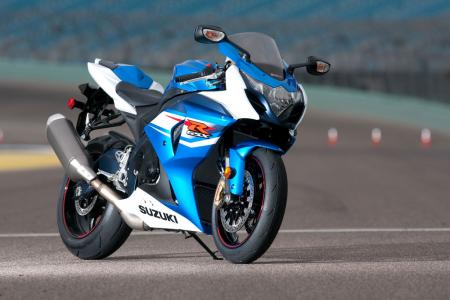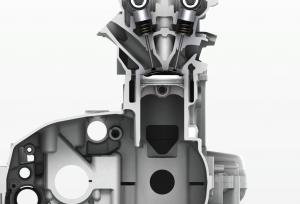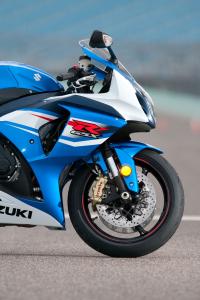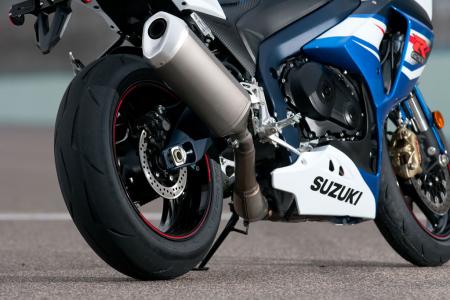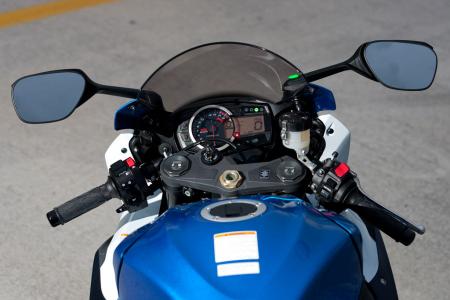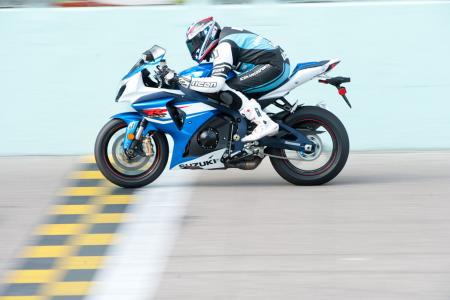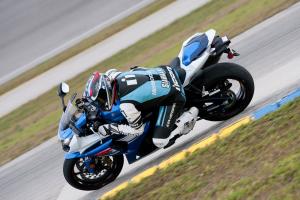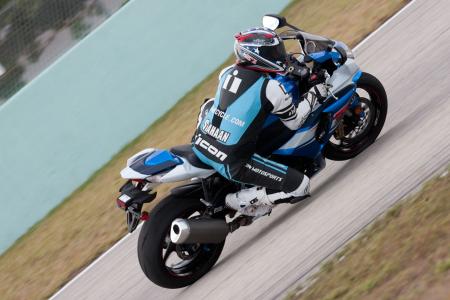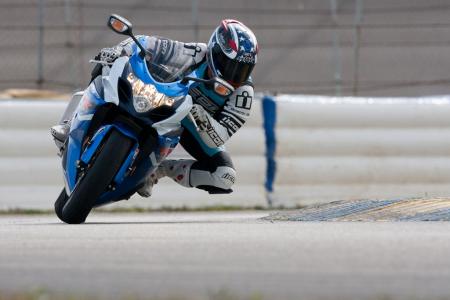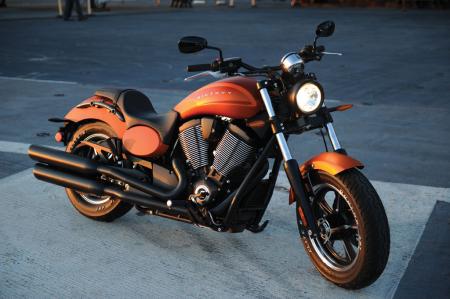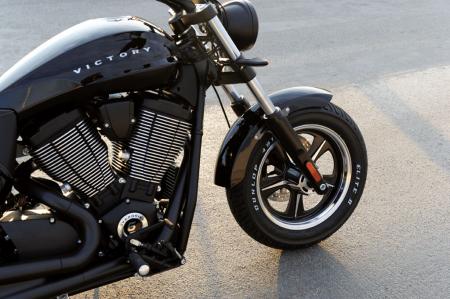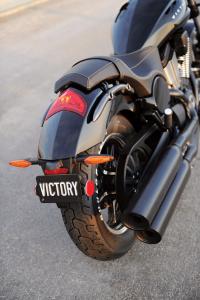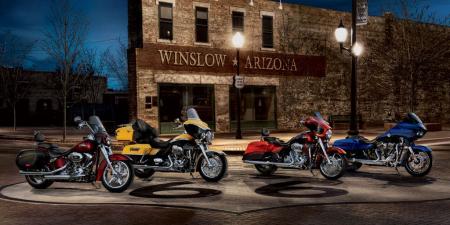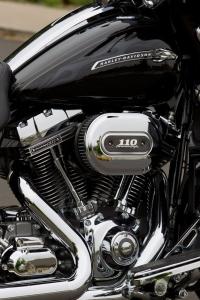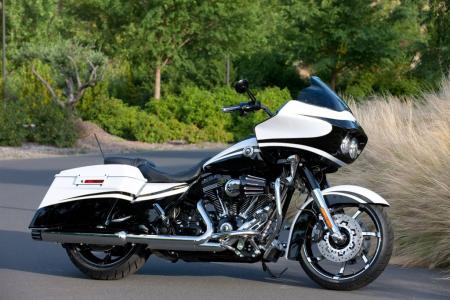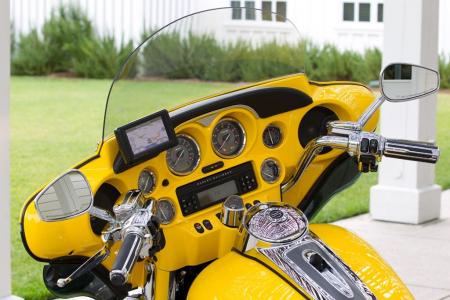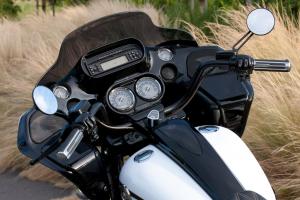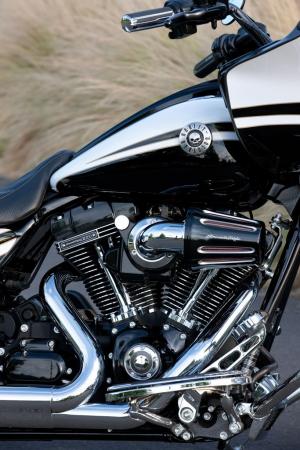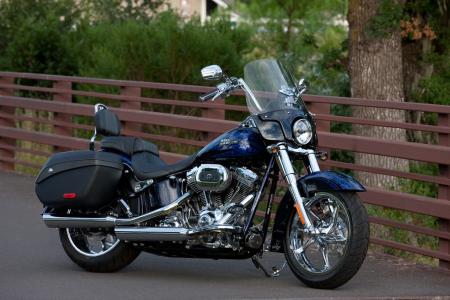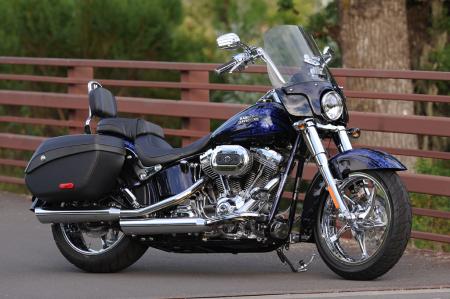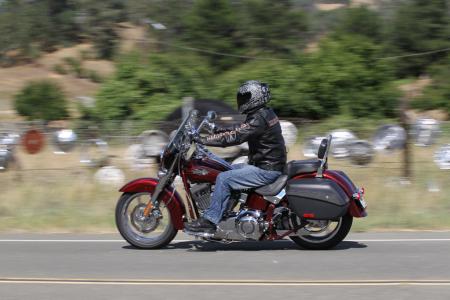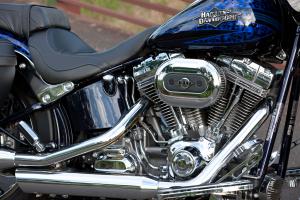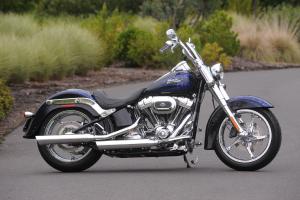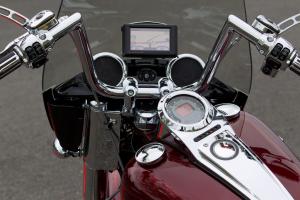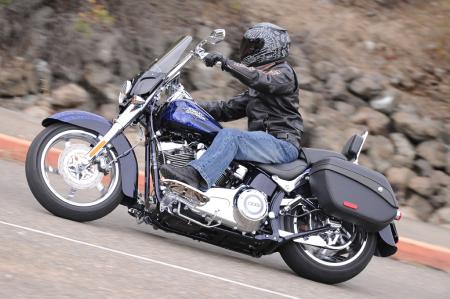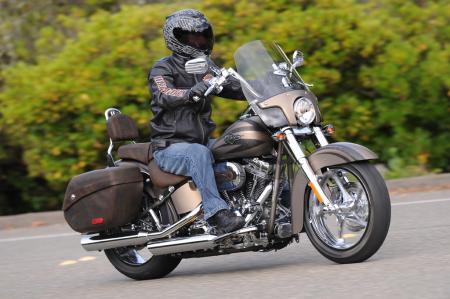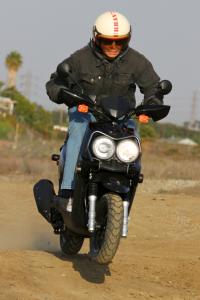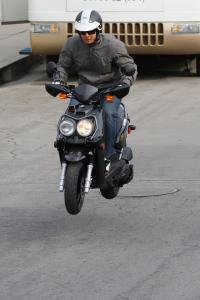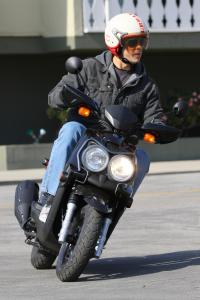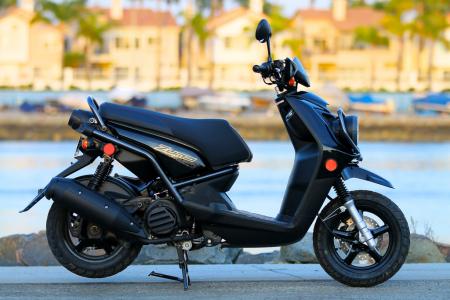 Harley-Davidson’s Custom Vehicle Operations, or more commonly, CVO, is the company’s in-house customizing arm. It’s like a company within a company, and Harley employees covet the opportunity to work for this branch of the Motor Company that takes standard Harley models and turns them into something special.
Harley-Davidson’s Custom Vehicle Operations, or more commonly, CVO, is the company’s in-house customizing arm. It’s like a company within a company, and Harley employees covet the opportunity to work for this branch of the Motor Company that takes standard Harley models and turns them into something special.
CVO bikes start as OE-model Harleys. A dedicated staff then works from the expansive array of goodies from Harley’s P&A (Parts and Accessories) division, as well a few touches exclusive to the CVO line, to craft these run-of-the-mill Harleys into tasteful works of rolling art.
Paint scheme pinstripes done by hand means no CVO bike is 100% identical to another, even if the same model. Furthermore, CVO paint schemes are available only within CVO – no getting a CVO paint job from the P&A catalog.
Underlining the exclusivity of CVO motorcycles are limited worldwide production numbers for each model.
While the approximate total CVO production for 2012 of 10,400 units seems like a lot, and is likely more units than Victory cranks out across its entire lineup, in light of the more than 222,000 bikes H-D sold worldwide last year, CVO total production is a drop in the Harley bucket.
Harley loves to tout the loyalty of the CVO owner.
Jeff Smith, a CVO team manager, said during Harley’s annual dealer meeting it’s common for dealers to sell a CVO bike over the phone to eager CVO regulars only minutes after the new models are revealed. These dyed-in-the-wool CVO lovers damn the dollar sign torpedoes when it comes to these turnkey customs from Harley.
Depending on the model, a CVO cruiser can easily crest $32,000. But CVO customers willingly accept what otherwise would make many riders spew a mouthful of American pilsner in disbelief the second a CVO’s price tag was revealed. However, the seasoned Harley CVO owner is perhaps wiser than their spendy ways indicate, for hidden in a CVO’s price is surprising value when it comes to a custom-style bike.
For example, a standard model 2012 Street Glide retails for $19,499, and now comes with the Twin Cam 103 engine. The 2012 CVO Street Glide, powered by a Screamin’ Eagle Twin Cam 110, retails for $32,699 – a $13,200 premium over the standard SG. Thirteen big ones is a chunk by just about any measure, but consider for a minute that a Screamin’ Eagle 110 engine upgrade from Harley retails for approximately $5200, and a color upgrade for the standard ’Glide from Harley’s HD1 Customization is another $5300.
So straightaway we have to spend $10,500 just to begin turning a vanilla SG into something of a CVO. But remember that the CVO paint is exclusive to CVO, and done primarily by hand, so obtaining equivalent custom paint would easily push past $5300.
Factor in the CVO Street Glide’s premium sound system with six very loud speakers, up-spec chrome wheels with style-matching brake rotors, custom-style seat with unique stitching, an entire package of stylish chrome accented components, ABS as standard, security system with alarm, and the CVO’s additional $13Gs starts looking a like deal if you’re hot for a top-shelf Harley.
Maybe those CVO devotees are on to something …
2012 CVO: Only A Few Changes, But Still Sweet Stuff
The 2012 CVO lineup remains at four models, a Street Glide, Road Glide Custom, Ultra Classic Electra Glide and Softail Convertible (which we’ll review more fully at a later date).
The Road Glide Custom is the only “new” model, so-to-speak, as last year a Road Glide was also in the CVO stable but as an Ultra fitted with a Deluxe Tour-Pak, a 16-inch windshield and amenities for the long-haul touring set. Don’t miss reading our full review on the 2011 CVO RG Ultra.
This year the RG Custom, while still a CVO, better represents a cruiser than a dedicated tourer. The trunk box is gone, the windscreen is short and dark tinted, there’s now a performance-oriented high-flow air cleaner, and a trio of subtler color schemes – with the black and white a particularly tough looking combo – lend a custom look without looking overly flashy.
Standard issue for all CVOs is the Screamin’ Eagle Twin Cam 110 engine, while lowered suspension translates into low seat heights. Otherwise, each CVO model is tailored in such a way as to stand out even next to its high-stylin’ brethren.
2012 Harley-Davidson CVO Ultra Classic Electra Glide $37,249
If Harley has a flagship model, the CVO Ultra Classic Electra Glide is it.
With one of the most comfortable rider and passenger perches in the business, generous storage capacity, an impressive audio system to keep you company mile after mile, heated seats and grips, lustrous chrome and bold paint, this is the CVO sled you’ll want if you’re looking for a high-end Harley to get you from one side of the country to the other, and points in between.
The most notable addition to the CVO ’Lectra for 2012 is a Road Tech Zumo 660 GPS by Garmin. This is a motorcycle-friendly GPS with a touchscreen display that’ll accept commands from gloved hands – a key feature for motorcyclists.
Also helpful, the GPS’ audio commands (“Turn left in 500 feet.”) are piped through the Electra Glide’s thunderous BOOM! sound system speakers that for this year include four 5.25-inch speakers and the BOOM! Bass Booster Ports located in the Tour-Pak trunk bottom liner for enhanced bass sound. The Booster Ports utilize the trunk like a subwoofer’s box, thereby avoiding the monetary and spatial costs of an actual subwoofer.
The Zumo 660 has a 4GB storage capacity for MP3 files, and the player menu is navigable via the ’Glide’s switchgear-mounted audio controllers that also operate the premium Harmon/Kardon audio system that’s SiriusXM ready. But if the Zumo’s 4 gigs of music storage aren’t enough, the Glide comes standard with an 8GB iPod nano that’s also operable via the radio controllers.
New pretty bits this year include Chisel wheels (17-inch front, 16-inch rear) in Mirror Chrome with matching Chisel front rotors. The voluminous Tour-Pak trunk box has a chrome wraparound LED taillight, while Diamond-Cut Charcoal inserts tart up the air cleaner cover, CB pod insert and the Tour-Pak’s lid insert. Harley’s Rumble Collection gives the gleaming chrome treatment to foot controls, heated grips and windshield trim.
The three new color combos on offer this year are Wicked Sapphire & Stardust Silver with Big City lights Graphics, Crystal Citron & Diamond Dust with Big City Lights Graphics, and the Electric Orange & Black Diamond with Big City Lights Graphics (you’d better like the color orange to get this one!).
As big a mouthful as those color schemes are, Harley staff assured us that CVO owners have an incredible ability to recite perfectly their bike’s color name.
This fully loaded American-made luxo-tourer is notably maneuverable considering its claimed running order weight in excess of 900 pounds. However, confidence and finesse are required at walking pace speeds, like when picking your way around a parking lot looking for a space or performing a tight-radius U-turn. Riders who are tiny, faint-of-heart or inexperienced need not apply.
Seasoned riders ready for the CVO big time will appreciate the Ultra’s low-ish 29.8-inch seat height, but due to the width of the supremely comfy saddle, riders with an inseam of 30 inches or less may not get both boots placed flat at a stop.
The Screamin’ Eagle Twin Cam 110 Vee doles out plenty of go-power for the biggest of the CVOs, and torque seems forever on tap. In our 2009 Luxury Touring Shootout, this engine platform spun the dyno drum to the tune of 75 hp at 5100 rpm and 88 ft-lbs at 3800 rpm. Those figures won’t have sportbikers gushing with excitement, but the Ultra feels surprisingly peppy at low revs, and sufficient roll-on power is at the ready for overtaking Slugo The Cager on the interstate.
While the throttle-by-wire throttle and EFI system operates optimally, with so much brute force available at the crack of the throttle from the big cube engine, throttle response tends to feel abrupt at times at low rpm, particularly right off idle. The Ultra Classic’s weight somewhat masks this sensation, whereas it’s more noticeable on the lighter weight Street Glide or Road Glide. A Harley staffer hit the nail on the head when suggesting that of the three big-displacement Twin Cam engines (96, 103 and 110), the 103 perhaps offers the best blend of increased power from the 96 with smoother power application when compared to the grunty 110-incher.
On the other hand, no one at the launch of the 2012 CVOs was clamoring for a smaller engine in this best-of-the-best, the Ultra Classic Electra Glide. Get your order in now, as this CVO is limited to 3400 units and should, along with the other CVOs, hit dealers/availability as of this writing.
2012 Harley-Davidson CVO Street Glide $32,699
Kevin and I love the Street Glide best of all Harleys for its ideal blend of handling performance, comfort level, wind protection, styling and buttery smooth power from its rubber-mounted 96-cubic-inch Twin. And we know we’re right in our collective assessment since this is the model the Motor Company sells more than any other.
The desirableness of this bike is reflected in the dreamy CVO version of the SG, as Harley will make 3500 CVO Street Glides in 2012 – 100 more than the Ultra Classic Electra Glide – and for only $200 more than last year’s model.
Now that’s sayin’ somethin’.
The 2012 SG doesn’t double up on chrome goodies or retina–searing paint, but it does receive an extra serving of music pumping power in the form of two new 5x7-inch saddlebag lid-integrated speakers that boost the CVO SG’s speaker count to a total of eight, two more than last year. Tucked in the left side saddlebag is a new 200-watt amp that in fact does double up things this year, taking total system wattage from 200 to 400 watts. This bike is a crazy-loud boom box on two wheels powered by a Screamin’ Eagle!
Sound clarity is excellent with no noticeable distortion at high volume from the two 5.25-inch speakers and bridged dual 2.0-inch tweeters in the dash, as well as the set of 6.5-inch speakers in the fairing lowers. Even at 80-plus-mph while wearing a full-face helmet and earplugs, sound quality from this bike is unmatched by any bike I’ve ridden that offers audio. The CVO SG also comes standard with an 8GB iPod nano that’s controllable from the switchgear audio controls.
The SG still rolls on Agitator wheels (19-inch front, 18-inch rear) and front rotors, but this year in Mirror Chrome flavor. The mirrors also get the chrome treatment this year, and the subtle but slick bar and shield console emblem is now red backlit when the bike powers up – its nonessential but very trick looking.
Tuckered out by walking from beer tent to beer tent at the rallies?
Then your tushy will appreciate a new two-piece low-profile saddle with custom style imprints and “big beast” leather inserts. The pillion pad is detachable, as is the matching backrest for the rider.
This ’Glide rarely provides serious points of complaints for us to consider, however, to reduce buffeting at freeway pace I would’ve liked a shorter screen than the 7.0-inch blade that’s standard on this bike.
Like so many women that suffer painful high heel shoes or agonizing wax treatments for fashion’s sake, so, too, does the SG sacrifice for its curb appeal. An element of styling common to all CVO models is the “slammed” look. This low riding profile is integral to a CVOs appearance but it comes at the cost of limited rear suspension travel – like a meager 2.0 inches of travel. Ill-effects from the cut down suspension are fairly transparent over well-maintained road surfaces, as ride quality is, at worst, average. However, your first encounter with a cluster of pothole patchwork or a cavernous expansion joint will serve as a jolting reminder of the suspension’s narrow range of motion when your hiney gets bucked off the saddle a couple inches or the impact from the bump is transmitted directly to your lower back.
Some saddlebag storage space is sacrificed in the name of powerful new speakers; otherwise, the Custom Vehicle Operations Street Glide is a deliciously decadent version of a
Motorcycle.com staff favorite Harley-Davidson. Read our 2011 CVO Street Glide Review to see just how fond we are of this motorcycle.
Available colors include Ruby Red and Typhoon Maroon with Phantom Flame Graphics, Hot Citrus and Antique Gunstock with Phantom Flame Graphics and Dark Slate and Black Diamond with Phantom Flame Graphics.
2012 Harley-Davidson Road Glide Custom $30,699
In one trim level or another, the Road Glide is often found in the CVO lineup.
For 2011 it was the Road Glide Ultra, a distance-loving tourer with plenty of room for momma and all her stuff. This year the Road Glide Custom trades the long-haul touring image for a look that says this bike is a boulevard bombing badass bagger. The RG Custom is unusually understated for a CVO model; to the point that if it didn’t have that 110-cubic-inch SE at its heart you might not suspect it was part of this high-end line of Harleys.
When the CVO staff pulled the cover off the RG Custom with White Gold Pearl and Starfire Black with Real Smoke graphics, my eyes widened and I was fully alert – the metabolizing-sapping effect from the large slice of pie I’d eaten earlier had worn off in an instant. When I first saw this motorcycle I knew it was not only the best looking CVO of 2012, but perhaps one of the most attractive mass-produced cruisers I’d seen in a long time.
Chrome-plated parts on the RG Custom are in unusually small numbers compared to most CVOs. Instead, a healthy amount of black accents tie in the darker, sedate hues of the three available color schemes. The engine covers are gloss black, while the cylinders also get a full treatment of black finish.
Mirrors, clutch and brake levers, as well as master cylinders and even muffler tips, are blacked out. Agitator wheels (19-inch front, 18-inch rear) in Contrast Chrome are only partially shiny, and the Screamin’ Eagle Heavy Breather air intake air cleaner cover has a Cutback Black finish. The 1.0-inch diameter internally wired one-piece handlebar is powder coated black – a smart color choice for the bar, as it allows your eyes to gaze effortlessly without interruption across the bike’s profile.
Within minutes of seeing this dark-themed CVO Road Glide I thought, “Is it possible? A Dark Custom CVO?”
My suspicion of this possibility was piqued when I noted the absence of Bar and Shield badges, and instead saw a simple chrome skull on the fuel tank sides and dead center on the top of the RG’s frame-mounted fairing.
While the 2012 CVO Road Glide Custom isn’t the result of collaboration between CVO and the Dark Custom staff, the DC influence is obvious (like the skull, for one thing). And while no immediate plans are in place to create such a cross platform styled CVO, Smith said that both styling teams have talked and continue to swap notes.
The RG gets a full complement of the Harman/Kardon audio system with a total of six in-dash speakers and 100-watts-per-channel of music-pumping power. Like the rest of the 2012 CVO line, the Custom is equipped with an 8GB nano.
Once you’re settled into the two-piece saddle (the pillion is removable) with color-matched cover and stitching depending on the bike’s paint scheme, you’ll notice two things: the big frame-mounted fairing looks like a lot of fairing real estate out front, and wind protection is quite good thanks to the aerodynamic Windsplitter windshield that creates a less turbulent pocket of air compared to the Street Glide.
Some riders prefer the frame-mounted fairing since wind buffeting is transferred to the frame rather than handlebar, as well as a slightly lighter effort steering sensation because you’re not wielding the fairing’s weight on the handlebar.
All true, I suppose, but for my tastes the RG’s fairing style creates the perspective from the saddle that there’s a lot of weight out front and the illusion the front-end is significantly longer than it actually is. It’s visually heavy, I guess. I prefer the Street Glide’s bar-attached fairing for its smaller profile and because I feel I can better manage the bike’s handling at low speeds, even if more weight is carried on the handlebar.
Personal preference is what it boils down to, because the Road Glide handles well, just differently than the SG. It also has an additional inch of rear suspension travel.
Regardless of my choice of style of Glides, there’s no question in my mind – the 2012 Road Glide Custom is the looker of the bunch. In addition to the White color, Candy Cobalt and Twilight Blue with Real Smoke graphics and Maple Metallic and Vivid Black with Real Smoke graphics are available paint schemes. Harley expects to make 2000 of this 2012 CVO model.
Other than the Electra Glide, the Convertible is the only other CVO to receive the Road Tech Zumo 660. And like on the Electra, a rider can operate the Convertible’s included iPod nano menus through the Zumo. Turn-by-turn driving commands will play through the dual 3.5-inch 2-way speakers nestled at the base of the windshield.
In CVO trim, this is the only Softail with cruise control and throttle-by-wire. ABS is standard to all CVOs, and great care was taken to create separate ABS modulators for the front and rear wheels on the Convertible to preserve its clean custom-bike styling, with the front unit tucked neatly out of sight behind the upper fork cover.
Three color options are available this year: Crimson Red Sunglow with Scarlet Crystal Graphics, Abyss Blue with Catacomb Graphics, and the Satin Pewter with Catacomb Graphics bike’s leather saddle and saddlebags come in an upscale distressed brown leather. Give that brown leather a few years’ worth of wear and it should develop a nice character-endowing patina.
The Convertible is the best selling CVO with women, no doubt a result of the Convertible’s low 26.1-inch seat height, the second lowest of all Harley motorcycles. The ladies will have further reason to celebrate with this year’s Convertible since all its updates and the addition of the Zumo 660 raised its MSRP by a mere $100 from 2011. But get on this one quick, girls (or guys) – only 1500 are slated for production.
Related Reading
2011 Harley-Davidson CVO Road Glide Ultra Review
2011 Harley-Davidson CVO Street Glide Review
2010 Harley-Davidson Electra Glide Ultra Limited Review
2010 Harley-Davidson CVO Model Line-Up Preview





 8:22 AM
8:22 AM
 Chiken Joe
Chiken Joe


